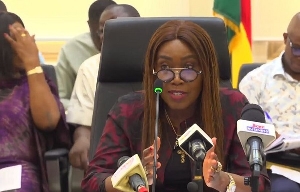- Home - News
- TWI News | TV
- Polls
- Year In Review
- News Archive
- Crime & Punishment
- Politics
- Regional
- Editorial
- Health
- Ghanaians Abroad
- Tabloid
- Africa
- Religion
- Election 2020
- Coronavirus
- News Videos | TV
- Photo Archives
- News Headlines
- Press Release
Opinions of Friday, 3 February 2006
Columnist: Kutsoati, Edward
Water Sachet Blues: An Ingenious Solution?
Imagine walking from point A to B in the scorching tropical heat in Ghana. You become very thristy. But no worries. With less than 500 cedis, you can get yourself a refreshing cool sachet of water to quench your thirst (after a struggle to to tear open one corner of the plastic sachet... eerrh with your teeth). By the way, why do they make it so hard to open these plastic sachets, huh? Here is an idea for the National Association of Sachet Water Producers (NASWP): design the sachets with a slightly thin line at one corner (as in "TEAR HERE") so we can easily open by tearing with two fingers.
But the bigger question is: What do you with the plastic sachet after emptying its contents into your belly? You do what everyone else does: you THROW it onto the street, or the gutter; as most streets are not lined with trash bins. So there lies a major a huge waste management problem in Ghana. Empty water sachets have made their homes on the streets and in the gutters, creating ideal breeding grounds for mosquitoes and a host of other insects. Our quest for a solution has been elusive. Last year, the Vice-President, Alhaji Aliu Mahama, launched a 16-member task force to manage the National Plastic Waste Management Programme (NPWMP). But the probramme quickly run into problems causing the NASWP and its sister group, the Ghana Plastic Manufacturers Association (GPMA), to pass a no-confidence vote in the 16-member task force.
But the solution may lie in a very simple technology that costs less than a few thousands cedis. The originator of this low, but efficient, technology is Mr Kofi Setordji, a Ghanaian sculptor and the permanent artist-in-residence at the ARTHAUS in Accra.
Mr Setordji's trash collector consist of 4 to 5 feet metal pole cast into a heavy cement block at the base, and shaped into a pointed hook-like edge at the top end. Finally, a thread is tied loosely at the base of the pole and run along the pole to the top (see the photo). It works as follows: after drinking your refreshing water, all you need to do is to stick the empty sachet onto the pole and push it down a bit. The pole can take up to 500; and when it is filled from base to top, we untie the thread at the base and pull the whole from the top end of the thread. The whole trash is simply collected on the thread and ready for disposal. The pole is then left empty, and using a new length of thread, it is ready for the next pile. THAT'S IT!!!
Now, you would think the Accra Metropolitan Authority (AMA) would be rushing in to see Mr Setordji. No!!! They are not interested. So please, if you are reading this, and you know someone at the AMA, pass this on to them.
Mr Setordji told me he is experimenting with the empty, decomposed sachets for a potential re-usable value; perhpas for his artwork or whether it can be used as a building material. Now, that is creativity; and it is right in Ghana. With its low cost, a local authority (such as the AMA) can buy lots of these trash collectors and place them at various points in Accra. Then let private trash collectors submit tender bids for a contract to clear the trash at regular intervals. If we have many of this simple trash collectors in Accra, getting people to use it in disposing off empty sachets will be relatively easy: simply because, AMA can buy a lot and space them a few meters from each other. So what's the AMA (or any local authority) waiting for? A made-in-the-China technology?
Thanks.












